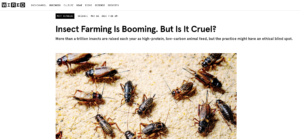https://www.wired.com/story/insect-farming-sentience/
Excerpt:
Insect farming is booming in a major way. By one estimate, between 1 trillion and 1.2 trillion insects are raised on farms each year as companies race to find a high-protein, low-carbon way to feed animals and humans. In terms of sheer numbers of animals impacted, this is a transformation of a speed and scale that we’ve never seen before.
It’s a weird twist in our already strange relationship with bugs. We squash them, spray them, eat them, and crush them to make pretty dyes. But we also fret about plummeting wild insect populations and rely on them to pollinate the crops we eat. And with the industrialization of insect farming, bugs are being offered up as a solution to the human-caused climate crisis. But before we go down that route, we need to ask some really basic questions about insects. Can they feel? And if so, what should we do about it?
…
Almost every time scientists search for insect nociception, they find it, says Lars Chittka, founder of the Research Centre for Psychology at Queen Mary University of London and author of The Mind of a Bee. There’s evidence for nociception in beetles, flies, bees, and butterflies. We also have good evidence that at least some insects can bring together sensory information in their brains, and that their nociceptors are connected to their brains. Plus, scientists have seen some evidence of insects grooming injured spots on their bodies—another indication of sentience. Some ants even rescue nestmates that have lost limbs after raids on termite mounds. Wound-tending is generally seen as a sentience marker.
If we’re going to farm animals that are candidates for sentience, then there should be welfare standards, says Birch. Right now there are no widely recognized welfare guidelines for farmed insects, and few laws that specifically require insect farmers to meet certain welfare standards. The EU body that represents insect farmers has set out five guidelines borrowed from vertebrate welfare law, but companies are generally left to decide for themselves what high welfare might look like. “If there are welfare concerns, you’ve got to intervene at the planning stages, when those facilities are being designed and constructed,” says Bob Fischer, a professor at Texas State University who works on insect welfare. There are many factors that farm designers need to take into account, including temperature, moisture levels, lighting, how crowded the insects are, and what they eat. For insect farmers, these are all engineering problems—they want to make sure as many bugs survive as possible and that the farms are cheap to run—but they’re also intricately tied to animal welfare.





